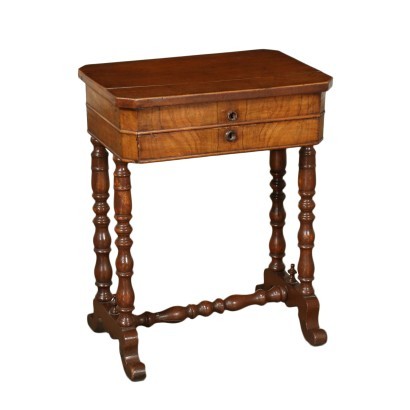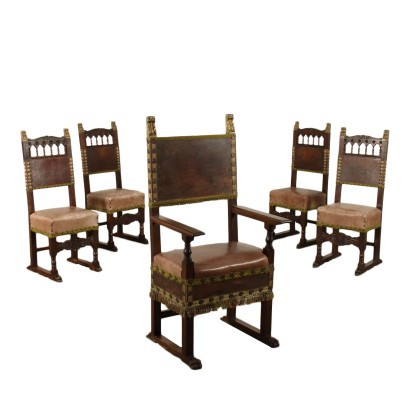Small Louis Philippe Table Walnut Poplar Cherry Italy 19th Century
Features
Style: Louis Philippe (1830-1848)
Age: 19th Century / 1801 - 1900
Origin: Italy
Main essence: Cherry , Walnut , Poplar
Material: Walnut Veneer
Description
Small Louis Philippe table supported by 4 refined legs that stand on curved feet connected to each other by a refined crossbeam. In the undertop band there is a small drawer with open compartments; the top can be open and it hides a divided open compartment. Walnut veneered with poplar and cherry interiors.
Product Condition:
Fair condition. Wear consistent with age and use. Any damage or loss is displayed as completely as possible in the pictures. Product with a Certificate of Authenticity and Lawful Origin.
Dimensions (cm):
Height: 73
Width: 57
Depth: 38,5
Additional Information
Style: Louis Philippe (1830-1848)
The Louis Philippe style develops in a context characterized by two main factors: the expansion of the bourgeoisie and the advent of the industrialization of production processes.This style therefore faces the decline of artisans and the new needs of economy and comfort.
Aesthetically it incorporates elements from the past, especially from the Gothic and the Renaissance, preferring very curved shapes for the seat backs, legs and deer-like feet, with a very rich decoration.
It mainly uses dark woods: ebony, rosewood and mahogany, side by side for contrast with light elements.
Find out more with our insights:
The Louis Philippe style
Classic Monday: Luigi Filippo and Umbertina consoles in comparison
Age: 19th Century / 1801 - 1900
19th Century / 1801 - 1900Main essence:
Cherry
Obtained from prunus cerasus , a plant of oriental origin, it is a hard wood with a light and delicate color, with a reddish vein. Due to its diffusion and availability it was used in Europe in popular furniture. In cabinet making, in the seventeenth century, it was widely used in France and England for inlay work. In Italy it was very successful in Lucca. It was also very popular in the United States for the manufacture, from the late 1600s, of commonly used furniture.The dictionary of antiques: Eclecticism
Classic Monday: a sofa from the 1800s example of eclecticism




























